User Manual

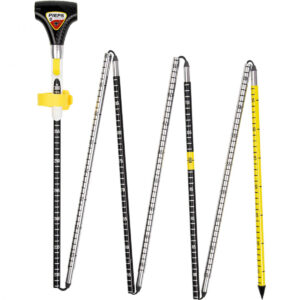
Pieps iPROBE BT
1. INTRODUCTION
Thank you for purchasing a PIEPS iPROBE BT!
Register your PIEPS device in the PIEPS APP (iOS, Android) or at my.pieps.com and get:
- Important information about your product
- Important information about software updates
With the following functionalities, the PIEPS iPROBE BT offers inexperienced beginners and trained professional rescuers maximum support at pinpointing and in multiple burials scenarios. It also saves valuable time when rescuing companions and at organized rescue operations:
- Optical and acoustic hit-indicator
- PIEPS SAFETY MARKER (with PIEPS 100cm and 40cm marker)
- Auto-Switch ON/OFF
- Wireless device management with Bluetooth and PIEPS APP
- Multiple burials support through automatic sleep-mode of PIEPS beacons with iPROBE support
- Centimeter scale
- Easy and fast assembly of the probe
- Speed-Cone system for quick extension
- Quick-closing-latch for reliable locking of the probe
- Elastic closure buckle
- Software updates
With the PIEPS iPROBE BT, you have a product that is state of the art in terms of safety and user-friendliness. Despite this, the PIEPS iPROBE BT can pose risks if used inappropriately or incorrectly. We refer to possible hazards in chapter Error! Reference source not found.. and with safety notes placed throughout the operating manual.
This operating manual is intended to ensure the safe use of the PIEPS iPROBE BT. The safety instructions in this document must be followed at all times. Before you use the PIEPS iPROBE BT, you must have read and understand this operating manual.
Pieps GmbH is not liable for technical or printing errors in this operating manual, neither is any liability accepted for damage caused directly or indirectly by the delivery, performance or use of this operating manual.
Copyright © Pieps GmbH, 08/2020This translation of the original manual is protected by copyright. All rights, especially the rights of reproduction, distribution and translation, are reserved. No part of this document may be reproduced or stored, processed, duplicated or distributed using electronic systems in any form (photocopy, microfilm or other method) without the written consent of Pieps GmbH. Violations may incur criminal penalties.
1.1 MARKINGS
In accordance with applicable regulations, the following marks may be found on the PIEPS iPROBE BT or/and on the packaging:
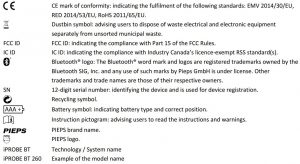
1.2 LIABILITY
The information contained in this operating manual describes but does not guarantee the features of the product.
No liability is accepted for damage caused by:
- Improper use,
- Failure to follow the operating manual,
- Unauthorized modifications of the PIEPS iPROBE BT,
- Improper work on and with the PIEPS iPROBE BT,
- Continuing to use the PIEPS iPROBE BT despite evidence of wear and tear,
- Unauthorized, improperly carried out repairs,
- Emergencies, external influences or force majeure.
NOTICEAlterations or modifications not explicitly approved by the manufacturer will result in you no longer being allowed to use the device.
1.3 WARRANTY CONDITIONS
The manufacturer provides a 2-year warranty covering manufacturing and material defects of the PIEPS iPROBE BT from the date of purchase. Exceptions are the battery, probe bag as well as any damage caused by improper use or dismantling of the device by unauthorized persons. Any other warranties and liability for consequential damage are expressly excluded. For warranty claims, please take proof of purchase and a description of the fault to the point of sale.
1.4 MANUFACTURER ADDRESS & SUPPORT
Pieps GmbH, Parkring 4, 8403 Lebring, AustriaFor technical problems, please contact the support: [email protected]
1.5 INTENDED USE
The PIEPS iPROBE BT is an electronic avalanche probe with an optical and acoustic hit indicator to every transmitting beacon (according to standard EN300718), as well as an automatic sleep-mode of beacons with iPROBE-Support. In practice, the PIEPS iPROBE BT is used for the pinpointing of a person buried by an avalanche and must be used for this intended purpose only. Detailed knowledge of avalanche prevention is as indispensable as regularly practicing victim searches in an emergency. The following procedures and tips relate only to special usage in conjunction with the PIEPS iPROBE BT. The basic line of action in an emergency – as explained in specialist publications and material from avalanche courses – must be followed. The PIEPS iPROBE BT must always be folded away on descents and stowed securely in the backpack (e.g. emergency pocket).
The PIEPS iPROBE BT is an electronic avalanche probe with a number of automatic functions – for this reason, the PIEPS iPROBE BT may only be commissioned after having read and understood the documentation. Failure to use the device as intended will result in all liability and warranty claims being rejected. The PIEPS iPROBE BT is to be operated only under the conditions of use described in the documentation.
1.6 TARGET GROUP AND PREVIOUS KNOWLEDGE
An avalanche probe should be part of the avalanche emergency equipment of everyone who ventures off from the secured piste into open, unsecured terrain (e.g. ski touring, freeriding, mountain rescue operations, etc.).
Users of the PIEPS iPROBE BT must meet the following conditions:
- Read and understand this operating manual.
- Users with impaired vision must ensure that they can read the multi-coloured optical display (LED-lights) and displays on the device as well as the instructions in the documentation without problem.
- If users with impaired hearing are unable to hear the acoustic signal, they must ensure that they can correctly interpret the display indications in accordance with the instructions in the operating manual.
- Regular training ensures safe and efficient use of the PIEPS iPROBE BT.
1.7 ESSENTIALS
The PIEPS iPROBE BT meets the current state of technology and the applicable health and safety regulations. However, incorrect operation or misuse can give rise to hazards for:
- The life and health of the users or third parties,
- The PIEPS iPROBE BT and property of the user,
- The efficient use of the PIEPS iPROBE BT.
1.8 TECHNICAL SPECIFICATIONS
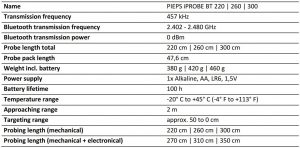
2. SAFETY
This operating manual is structured in accordance with the applicable EU regulations and contains safety instructions. Each individual is personally responsible for complying with the safety instructions. This chapter contains all safety-related information.Should anything be unclear or difficult to understand, please contact our support team.
2.1 SIGNAL WORDS USED IN THE SAFETY INSTRUCTIONS
![]() DANGER: Imminent threat to the life of individualsA safety instruction with the signal word DANGER indicates an imminent threat to the life and health of individuals!
DANGER: Imminent threat to the life of individualsA safety instruction with the signal word DANGER indicates an imminent threat to the life and health of individuals!
![]()
![]()
![]()
![]()
![]()
![]()
![]()
![]()
![]()
![]()
![]()
![]()
![]()
![]()
![]()
![]()
![]()
![]()
![]()
![]()
![]()
![]()
![]()
![]()
![]()
![]()
![]()
![]()
NOTICEThis symbol with the text NOTICE indicates supporting information.
2.2 GENERAL SAFETY RULES AND OBLIGATIONS
The following safety rules and obligations apply in general for using the PIEPS iPROBE BT:
- The PIEPS iPROBE BT must only be used in perfect condition.
- It is forbidden to change the PIEPS iPROBE BT without the written permission of Pieps GmbH.
- Do not attempt to repair damage or malfunctions without authorization. Instead, contact our support, who will tell how to proceed. The PIEPS iPROBE BT must not be used until the damage/malfunction has been repaired.
- The safety and operating instructions in the operating manual must be followed at all times.
2.3 RESIDUAL RISKS | WARNINGS
Even though the PIEPS iPROBE BT has been designed with maximum care and all safety-related facts have been taken into consideration, residual risks may exist and must be evaluated by means of a risk assessment. All residual risks and warnings from the risk assessment are listed in this chapter.
![]()
![]()
![]()
![]()
![]()
![]()
![]()
![]()
![]()
![]()
![]()
![]()
![]()
![]()
![]()
![]()
![]()
![]()
![]()
![]()
![]()
![]()
![]()
![]()
![]()
![]()
![]()
![]()
![]()
![]()
![]()
![]()
![]()
![]()
![]()
![]()
![]()
![]()
![]()
![]()
![]()
![]()
![]()
![]()
![]()
![]()
![]()
![]()
![]()
![]()
![]()
![]()
![]()
![]()
![]()
![]()
![]()
![]()
![]()
![]()
![]()
![]()
![]()
![]()
![]()
![]()
![]()
![]()
![]()
![]()
![]()
![]()
![]()
![]()
![]()
![]()
![]()
![]()
![]()
![]()
![]()
![]()
![]()
![]()
![]()
![]()
![]()
![]()
![]()
![]()
![]()
![]()
![]()
![]()
![]()
![]()
![]()
![]()
![]()
![]()
![]()
![]()
![]()
![]()
![]()
![]()
![]()
![]()
![]()
![]()
![]()
![]()
![]()
![]()
![]()
![]()
![]()
![]()
![]()
![]()
![]()
![]()
![]()
![]()
![]()
![]()
NOTICE: If the PIEPS iPROBE BT is defect (system error self-test), no electronic functionalities are available, and any electronic support will lapse. In this case, use the PIEPS iPROBE BT like a classic avalanche probe.
NOTICE: The user must read the operating manual!
3. PACKAGING
- 1x PIEPS iPROBE BT
- 1x battery (in battery compartment)
- 1x storage bag
- 1x Quick Start Guide
Check that the contents are complete and undamaged after unpacking. If necessary, contact your point of sale or our support team. A correct disposal of the packaging is an environmentally friendly manner (paper to paper, plastic to plastic, etc.).
![]()
![]()
![]()
![]()
![]()
![]()
![]()
![]()
![]()
![]()
![]()
![]()
![]()
![]()
4. GENERAL DESCRIPTION
4.1 STRUCTURE
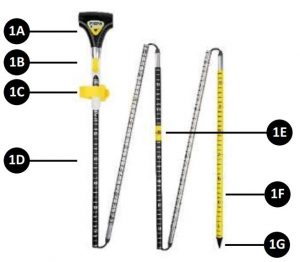

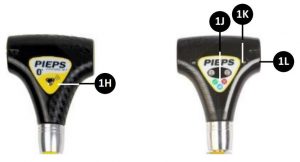

- (1A) Probe handle with LED display and loudspeaker for optical and acoustic indication of system status
- (1B) Quick-closing latch for reliable locking of the probe
- (1C) Elastic closure buckle for secure closure
- (1D) Probe tube with centimeter scale for reading burial depth and as centimeter measurement for snow profiles
- (1E) PIEPS Safety Marker: 100 cm marking
- (1F) PIEPS Safety Marker: last 40 cm marking
- (1G) Probe tip with integrated receiver localizes any standard avalanche beacon
- (1H) Loudspeaker for acoustic indication of system status
- (1J) LED-lights in green, red and blue for optical indication of system status
- (1K) Battery symbol with polarity indication
- (1L) Battery compartment access
4.2 SWITCHING ON | SELF-CHECK
To switch on the PIEPS iPROBE BT go through these steps:
- Open the elastic closure buckle (1C).
- Eject the PIEPS iPROBE BT into soft ground (snow) and tension the probe. To do so, hold the top part of the probe tube with one hand and with the other hand pull the probe handle (1A) until the quick-closing latch (1B) clicks into place and a beep from the loudspeaker (1H) indicates that the PIEPS iPROBE BT is switched on.


NOTICEThe switching on of the electronic is confirmed with an acoustic (Piep-tone) signal. Continuous signal for 1 second (piiiiiiiiiiep)
4.2.1 Self-check
When switching on the PIEPS iPROBE BT an extensive self-check is performed, and all relevant system components are tested.
- If the PIEPS iPROBE BT is OK (self-check “OK”), a green LED-light lits for 1 second. The LED-light of the Check A1 then starts flashing and the PIEPS iPROBE BT can be used.
- If the battery needs to be replaced (low battery capacity self-check), a red flashing LED light and an acoustic warning signal will be indicated for 3 seconds. The LED-light of the Check A1 then starts flashing and the PIEPS iPROBE BT can be used. In this case, replace the battery.
- If the PIEPS iPROBE BT shows an error (system error self-test), a permanent red LED-light and an acoustic warning signal will be indicated for 3 seconds. The optical warning will continue as long as the PIEPS iPROBE BT is activated. The electronic functionalities are not available. In this case, perform troubleshooting.
NOTICEIf the PIEPS iPROBE BT is defect (system error self-check), no electronic functionalities are available, and any electronic support will lapse. In this case, use the PIEPS iPROBE BT like a classic avalanche probe.
4.3 FUNCTIONALITY DURING OPERATION


4.3.1 Check A: Search mode | Proximity indicator | Hit indicator
The optical and acoustic hit indicator gives you maximum support and saves valuable time at pinpointing! In search mode (Check A1), the PIEPS iPROBE BT searches for a transmitting beacon. From a distance of approx. 2 to 0.5 m between probe tip and transmitting beacon, the proximity indicator (Check A2) is indicated. From a distance of approx. 0.5 – 0 m, the PIEPS iPROBE BT signals a hit (Check A3).
NOTICEThe proximity and hit indicators operate for each transmitting beacon that transmits according to standard EN300718.
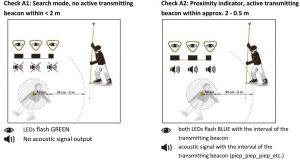

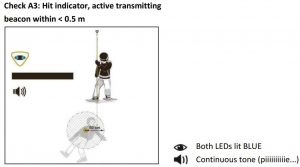

4.3.2 Check B: Transmitter deactivation – Sleep-mode
The automatic sleep-mode of beacons with iPROBE-support saves time in multiple burials scenarios. The display of the receiving beacon shows the next strongest signal without pressing the MARK-button. The rescuer can start with the search immediately.
A transmitting beacon is automatically deactivated after the hit indicator (Check A3) if the transmitting beacon has iPROBE-Support* and the iPROBE is in a vertical position in the snow. Deactivation (sleep-mode) takes place within a few seconds.
* Avalanche beacons with PIEPS iPROBE-Support: PIEPS PRO BT, PIEPS POWDER BT, PIEPS MICRO BT sensor/button/RACE, PIEPS DSP SPORT, PIEPS DSP PRO/PRO ICE, , PIEPS DSP STANDARD/TOUR ≥ v5.0, PIEPS FREERIDE, BLACK DIAMOND GUIDE/RECON.
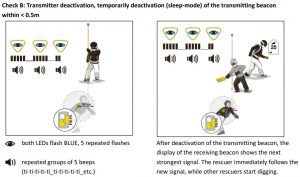

As long as the PIEPS iPROBE BT remains in the near range (0 – approx. 0.5 m) of the transmitting beacon, the beacon remains deactivated (stays in sleep-mode). If the PIEPS iPROBE BT is removed or changed to the horizontal position, the transmitting beacon starts transmitting again after 5 seconds.
After being moved away from the transmitting beacon, the PIEPS iPROBE BT remains in Check B until:
- The PIEPS iPROBE BT is changed from the vertical position to a horizontal position < 20° (carrying position). In this case, the PIEPS iPROBE BT switches automatically to search mode (Check A1).
- Or a new transmitting signal is received. In this case, the PIEPS iPROBE BT switches automatically to the proximity indicator (Check A2) or hit indicator (Check A3).
NOTICEIf the transmitting beacon does not have iPROBE-Support, the transmitting beacon is not deactivated and the PIEPS iPROBE BT remains in Check A3 mode (hit indicator).
NOTICEThe function „Sleep-mode“ can optionally be deactivated in the PIEPS APP.
4.4 SWITCHING OFF & CORRECT FOLDING
The PIEPS iPROBE BT switches off automatically when tension is removed, and the probe is folded.
For switching off and folding proceed the following steps:
- Press the quick-closing latch to release the lock and pull gently on the probe handle (2A).
- Start the folding process with the bottom probe tube and fold the next probe tube parallel to the first one (2B). Push the tube until it stops (2C).
- Repeat the process with the remaining probe tubes until the PIEPS iPROBE BT is completely folded (2D-2H).
- Fix the folded probe with the elastic closure buckle (2J).
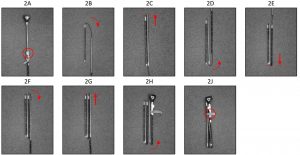

NOTICEAlways start the folding procedure with the bottom probe tube and always push the probe tubes until they stop before starting the next folding procedure. This ensures a long life of the probe cable.
4.5 IN CASE OF EMERGENCY
A buried person has the greatest chance of being rescued by an efficient companion rescue. In the event of an accident, the following applies: KEEP CALM, OBSERVE, ALERT, ACT WITH COORDINATION!
(1) Keep calm & get an overview
- Are there any other risks?
- How many victims?
- Determine the primary search area!
(2) Make a brief emergency call
- EU 112, AT 140, CH 1414, IT 118, FR 15, NA 911
(3) Burial search
- Signal search (eyes + ears, beacon)
- Coarse search (starting with initial signal)
- Fine search (closer than 5 m on the surface)
- Pinpointing (systematic probing)
(4) Systematic digging(5) First Aid(6) Rescue
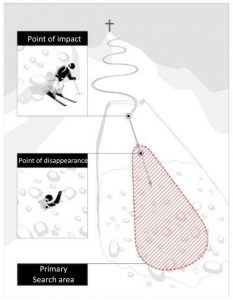

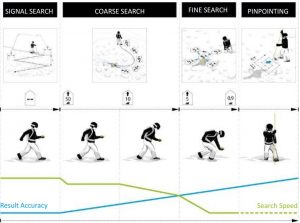

4.5.1 Pinpointing
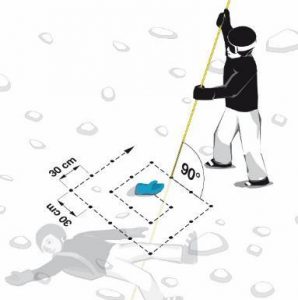

Always probe perpendicular to the surface. Use your lower hand as a “probe guide” to ensure the probe follows a steady path. Follow a proven system until you have a hit. Communicate a hit clearly to companions. Leave the probe stuck for shovelling guidance.
The PIEPS iPROBE BT supports perfectly through an optical and acoustic hit indication within 50cm to the burial.
IMPORTANT Leave probe in place during the whole digging work! The probe serves as an indispensable orientational guide.
4.5.2 Combination of fine search and pinpointing
This is a special probing system for the PIEPS iPROBE BT.
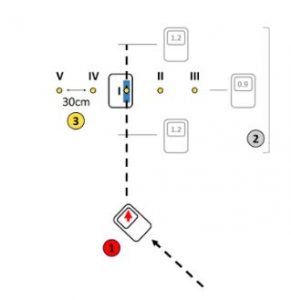

Last correction of the direction: Do an accurate direction adjustment before the direction arrow disappears (1).
Fine search: Mark the point of the lowest distance reading already at the first movement forward.
Start probing with the PIEPS iPROBE BT with 30 cm-distances till you hear a continuous signal -> central (I), 2x right (II,III) and 2x left (IV, V).
5. DEVICE MANAGEMENT WITH THE PIEPS APP
Bluetooth and the PIEPS APP allow a straightforward device management (e.g. software update, device configuration) and additionally provide a handy training mode.
Get the PIEPS APP (Android Play Store, iOS App Store), connect your PIEPS beacon and take advantage of all features!
NOTICEIf the PIEPS APP is already installed, be aware to use the latest version
To connect the PIEPS iPROBE BT with your Bluetooth-device, follow these instructions:
- Activate the PIEPS iPROBE BT and lean it on a wall with the upturned probe tip within 60 seconds.
- When the PIEPS iPROBE BT is ready to connect, this is confirmed with an acoustic (2x piep) and optical (simultaneous flashing of the green and blue LED-lights) signal (after approx. 10 seconds).
- Follow the instructions of the device manager in the PIEPS App to build up a connection (Notice: When no connection is built up within 5 minutes, the PIEPS iPROBE BT needs to be deactivated and activated again.)
- A successful connection is indicated with a permanent blue and a flashing green LED-light.
- After a successful connection the system checks and updates can be performed. Therefore, follow the instructions in the PIEPS APP.
- To end the Bluetooth-mode, unlink the PIEPS iPROBE BT in the PIEPS APP or turn the probe so the probe tip is on the ground again.
- Bluetooth error: A Bluetooth error is indicated with a permanent red and a flashing green LED-light.
NOTICEThe Bluetooth connection is automatically interrupted after 5 minutes of inactivity!
![]()
![]()
In the PIEPS APP the following settings can be made:


Further useful features of the PIEPS APP:
- Software Updates
- Training mode
- Practical scenarios
- Fleet management
6. TROUBLESHOOTING, MAINTENANCE, STORAGE, DISPOSAL
6.1 TROUBLESHOOTING
When the PIEPS iPROBE BT shows no indication when switching on or a system error is indicated after the self-check., perform the following instructions:
- Deactivate the PIEPS iPROBE BT (remove tension and fold the tubes)
- Check the PIEPS iPROBE BT for physical damage.
- Check the battery capacity, type and polarity (+,-). Replace the battery.
- Activate the PIEPS iPROBE BT again.
- Perform a device-check in the PIEPS APP.
If the PIEPS iPROBE BT still shows no indication or a system error, please take the device to your retailer or contact our support () .
6.2 BATTERY REPLACEMENT
The PIEPS iPROBE BT analyses the charge remaining in the battery each time the probe is switched on. If the charge reaches a critical level, a warning will be indicated after the self-test for 3 seconds. PIEPS recommends replacing the battery immediately, even though there should be enough power left for another 1 – 3 rescues.
Replace the battery as follows:
- Unscrew the cover of the battery compartment anticlockwise (3A).
- Replace the battery with 1x Alkaline, AA, LR6, 1,5V. When installing the new battery, make sure the polarity is correct (3B).
- Dispose of the battery in accordance with the law in your country.
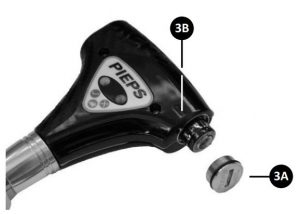

![]()
![]()
![]()
Only use batteries of type „Alkaline, AA, LR6, 1,5V“!
6.3 CLEANING
Use a damp cloth without cleaning agent to clean the device.
NOTICEFlowing water, steam or cleaning agent must not be used to clean the device. To do so could impede operation of the device.


STORAGEStore the device in a dry room at room temperature.


NOTICEIf the device is not used for extended periods of time (summer months), it is recommended to remove the batteries from the battery compartment. The warranty does not cover damage caused by leaking batteries.
![]()
![]()
![]()
6.5 DISPOSAL
NOTICE
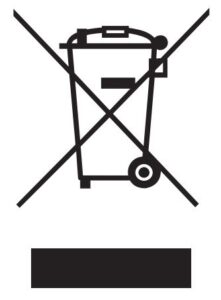

7. CONFORMITY
EUROPEHereby, Pieps GmbH declares that the radio equipment type PIEPS iPROBE BT is in compliance with Directive 2014/53/EU. The full text of the EU declaration of conformity is available at the following internet address: www.pieps.com/conformity
Pieps iPROBE BT User Manual – Pieps iPROBE BT User Manual –
Questions about your Manual? Post in the comments!

